Winter rolls around every year, and with it comes the challenges of driving on snowy roads. Did you know that over 70% of US roads are in areas that see regular snowfall? Whether it's dry snow or a melting slush, a snow-covered highway can seriously hamper tire-road contact. And if regular vehicles need to be cautious, imagine the challenges for an 80,000-pound 18-wheeler! Longer braking distances and reduced maneuverability become the norm. In this article, we'll dive into essential winter driving tips for truck drivers and habits to keep in mind when the snow starts falling.
Contents:
- Why winter driving tips for truck drivers are important?
- Plan Your Route
- Adapt and Adjust Your Habits
- Invisible Villain: Black Ice
- Keep a Clear View
- Slow It Down
- Give Yourself Room to Brake
- Keep Your Distance
- Anticipate the Road Ahead
- Tune into Fellow Truckers
- Gear Up for the Cold
- Keep That Tank Full
- Tools for Tackling Snow and Ice
- Keep Your Rig Winter-Ready
- Give Your Truck a Once-Over
- Winter Driving Tips for Truck Drivers: Is There a One-Size-Fits-All Approach?
- Conclusion
Why winter driving tips for truck drivers are important?
Veteran truck drivers are well-versed in winter driving tips and always prepare for the colder months. This knowledge stems from experience, both good and bad. Winter conditions can be treacherous, and it primarily comes down to traction. Snow and ice drastically reduce tire grip on the road. Moreover, the chilly temperatures aren't comfortable for either you or your big rig.
Even though snow graces our roads and highways annually, it's always worth reminding both rookies and seasoned drivers about the unpredictable challenges winter can bring. Let's examine the fundamental tips for driving a truck in winter.
Plan Your Route
Every trucker should make it a habit to check the weather forecast for their upcoming trips. Be in the know about what weather awaits you at your destinations. If you're traveling from East to West, say coast to coast, weather conditions tend to remain relatively consistent. But if you're heading from South to North, like from Florida to Illinois, the weather can shift dramatically from late October to early April, changing every 100 miles or so. One moment it's sunny and warm, and the next, you're dealing with slushy roads, biting winds, heavy snowfall, and the treacherous black ice.
Always check the National Weather Service for the latest weather warnings and conditions before hitting the road. They also offer contact info for checking road conditions in every state. Stay safe out there!
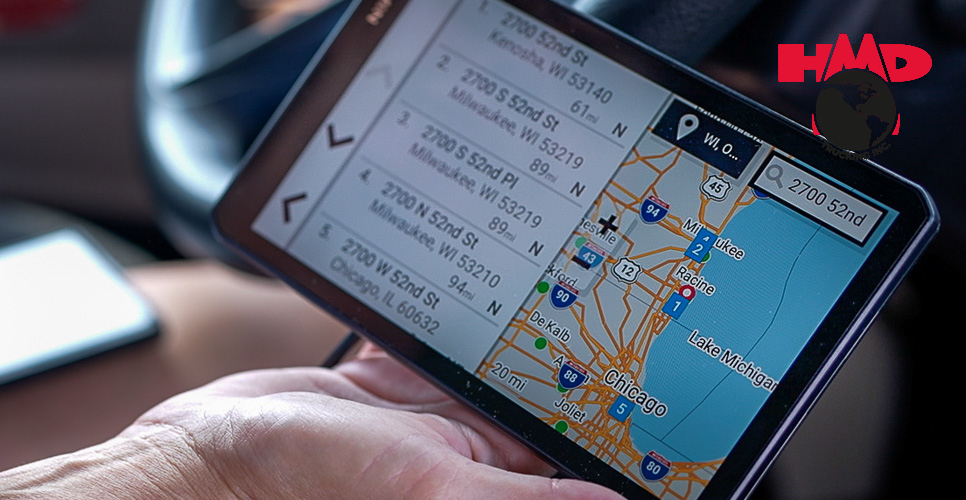
Adapt and Adjust Your Habits
We'll cover everything you need to know to tackle truck driving in winter weather head-on. While your safety on winter roads does depend on your truck's condition and the efforts of state and local agencies to clear the roads, the bulk of the responsibility rests on your shoulders.
Always be alert to changes on the road. If you spot snow dust, patches of packed snow, black ice, or if there's mist or snowfall, slow down. Yeah, it might set back your ETA a bit, but it'll greatly improve your safety. Driving slower gives you more time to react, especially when roads are slick and braking distances increase. And remember, you're not the only one slowing down. Stats show that average highway speeds drop by 13-40% in winter, depending on the weather. So, take it easy and stay safe.
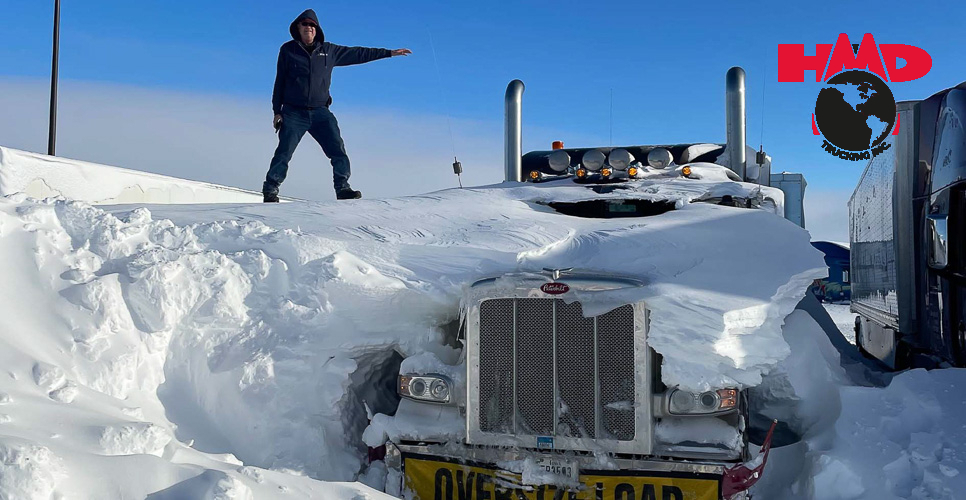
Invisible Villain: Black Ice
According to statistics, more accidents during winter driving occur on black roads than on those visibly covered with snow and ice.
Don't be deceived. Roads that appear clean and safe can be treacherous and dangerous. Their hazards aren't always visually apparent, leading truck drivers and motorists to drive as they would in summer conditions. However, under certain weather conditions, these black roads might be coated with a thin layer of ice, significantly reducing traction. Drivers might only realize this when it's too late, like when a car starts spinning or a truck begins to jackknife.
Bridges pose a particular risk when the first freeze hits. Unlike regular roads, bridges, with their elevated structures exposed to the air, freeze faster. Raindrops can quickly turn into invisible ice upon contact. The same occurs when snow or ice melts during the day and refreezes overnight. This results in a transparent glaze on the road surface, which is challenging to distinguish from the rest of the asphalt.
Regrettably, there's no safe speed for driving on ice. An 18-wheeler can lose control even at 10 MPH, and so can smaller vehicles, which might then collide with your tractor trailer after losing traction. Be especially cautious when approaching and driving on bridges. Reduce your speed if you notice melting snow on the road, as black ice might be nearby. Maintain a safe distance from motorists who continue to speed on potentially icy roads.
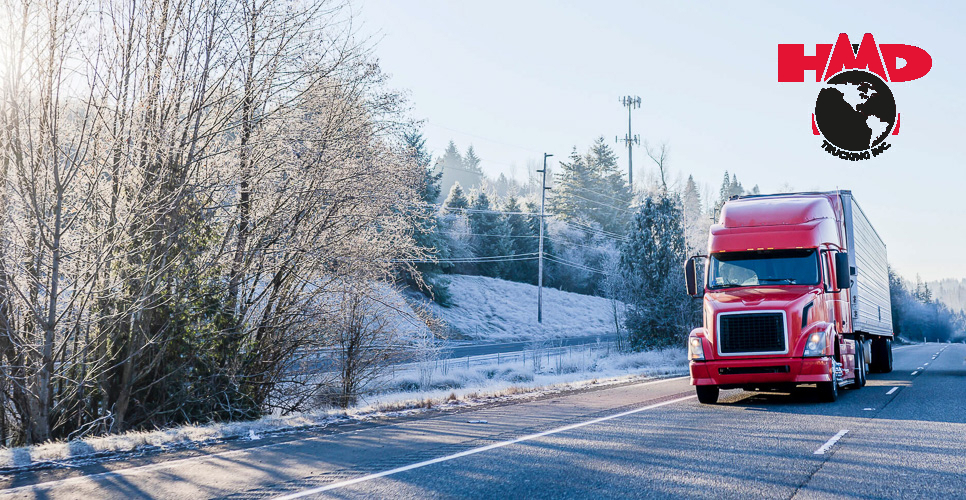
Keep a Clear View
Adapting to changing conditions on the fly is key. Always make sure you've got a clear view of the road ahead. Avoid driving in those snow clouds kicked up by big rigs in front of you. And remember, your 18-wheeler throws up the same kind of snow cloud. There might be a driver out there, not paying attention, trying to pass you within that cloud. Always be on the lookout, especially in low-visibility situations.
And don't forget those turn signals. Those blinking lights can cut through snowfall and powder, making sure other drivers see your moves, whether you're changing lanes or making a turn. Trucking in snow isn't just about your own safety. It's also about ensuring that motorists and fellow big rigs around you are driving safely. So, don't become a hazard on the road. Always make your intentions clear to other road users.

Slow It Down
Here's a golden rule for winter driving: slower is safer. As we've touched on, when roads are slick with snow or ice, the traction just isn't the same. Your truck's tires won't grip the road as securely as they would on a clear, dry day. And the scary part? You might not realize it until it's too late.
Give Yourself Room to Brake
Braking on winter roads can be tricky. The distance it takes to come to a full stop can be much longer than you'd expect, especially if the roads are slick. If your truck's wheels lock up when you hit the brakes, you'll need even more space to slow down. Ask yourself: is there enough room in front of your rig? Also be cautious with the engine brake, especially if there's ice on the road. Your drive wheels could lock up. Always anticipate what could increase your braking distance and plan accordingly.
Your truck's response to steering might not be as sharp as you're used to, either. On a slippery road, instead of changing lanes, your 18-wheeler might just skid straight ahead. Always give yourself plenty of space and time to brake and make your moves.
Keep Your Distance
The best way to avoid trouble? Keep a safe distance from the vehicle in front of you. A good rule of thumb is to double the usual following distance. Sure, some seasoned truckers might say it's tough since other drivers will try to squeeze into that space. But it's always worth the effort to stay safe.

Anticipate the Road Ahead
One of the hallmarks of a safe truck driver is the ability to anticipate challenges. Think like a Jedi – try to see things before they happen. To do that, make sure you've got a clear view of the road. Thanks to your truck's high seating position, you've got a vantage point most drivers don't. You're not blocked by SUVs, vans, or cars. So, steer clear of other big rigs, don't tailgate, and make sure you can see at least 100 yards ahead. A good sign you're at the right distance? You can see the brake lights of vehicles that far in front of you.
Tune into Fellow Truckers
For road safety, sometimes the old ways are the best. Keep that CB radio on and listen to what other drivers are saying. They'll give you the heads-up on road conditions, and if things get dicey, like a pile-up on an icy stretch, they've got your back.

Gear Up for the Cold
A quick glance at the weather forecast might remind you to pack some warm winter gear. A trip from South to North in the winter could mean swapping out a t-shirt for a cozy jacket, trading a cap for a snug beanie, and ditching sneakers for sturdy winter boots. And let's not forget those essential winter gloves – they're a lifesaver when you're cranking the trailer landing gear in sub-freezing temperatures.
If you're heading into colder regions, especially from the warmer southern states, be ready. Pack warm clothes and even a spare set in case you get wet.
Essentials include:
- warm work gloves;
- winter boots;
- warm hat, and a scarf or buff.
Make sure you've got a high-visibility jacket that fits over your winter gear, or invest in one with reflective stripes. And don't forget: warm blankets, and extra water and food are always good to have in your cab.

Keep That Tank Full
Your truck is your lifeline out there. Always have enough fuel so that if you're stranded in harsh winter conditions, your engine and auxiliary power unit keep running. Even if you think you've got enough fuel, don't hesitate to top off more often in the winter. What seems like a safe reserve from spring to fall might not cut it in the colder months. And while you're at it, keep extra anti-freeze windshield washer fluid and a spare set of wiper blades on hand. They can be game-changers in winter weather.
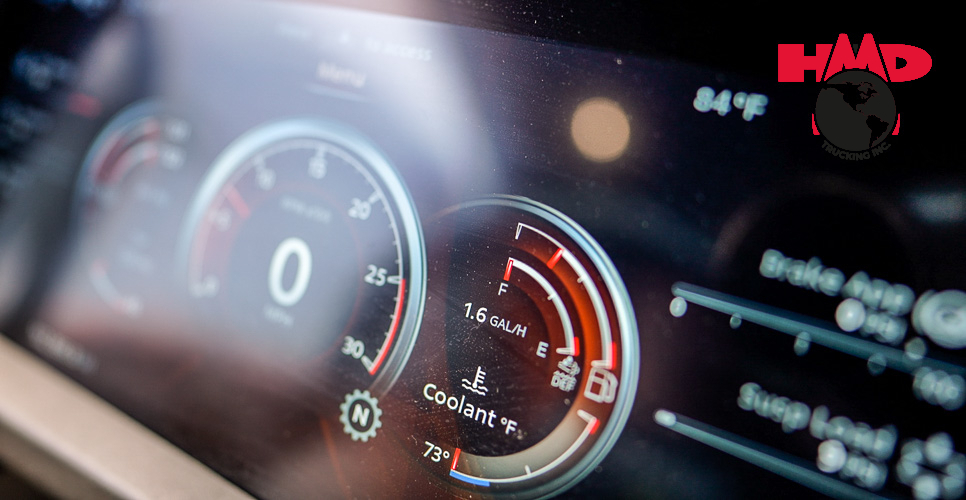
Tools for Tackling Snow and Ice
Winter can throw all sorts of curveballs. Be ready with tools to help you handle snow drifts and icy patches, even in places you'd least expect, like parking lots. A compact, foldable snow shovel and brush can help you clear your truck and the surrounding area. If your rig experienced snow storm and in the morning you found it covered in snow, it's on you to clear it off. A headlamp can be a lifesaver when you need extra light during those dark winter nights.
For those who really want to be prepared for the worst winter can offer, consider carrying bags of sand and salt. They can provide the traction you need if your wheels are spinning on ice. And don't forget about snow chains. They're not just useful; they're mandatory in some areas during the winter. Check out the tire chain laws by state to make sure you're compliant.
Keep Your Rig Winter-Ready
Even if you're not the one doing the maintenance as a company driver, make sure your carrier's keeping their trucks in tip-top shape. Remember, electrical and fuel systems can act up in freezing temps. It's reassuring to know your semi's battery is fresh and fully charged as winter rolls in. Your alternator should be pumping out enough juice to keep that battery charged up. And always have a set of jumper cables on hand, whether it's for your rig or to help out another driver. Know how to hook 'em up correctly to both trucks.
Tires? They're your lifeline on the road, especially when trucking in the winter. If yours are looking worn, swap them out for some with deep treads that'll grip the asphalt tight. And speaking of fuel, a fresh fuel filter is a good idea. Even more crucial? Filling up with winterized diesel. It's got additives to stop it from gelling in the cold. Make sure you've switched over to it before heading into areas where temps drop below freezing (that's 32°F, by the way).
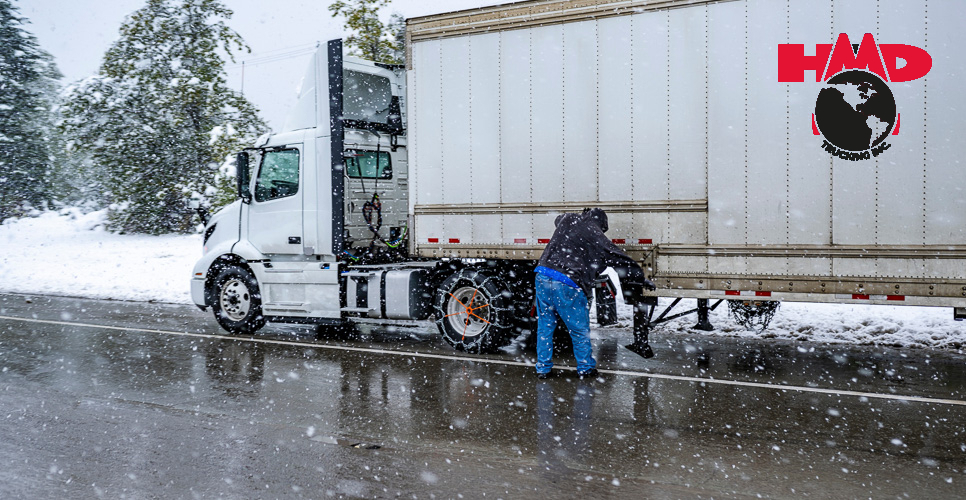
Give Your Truck a Once-Over
Winter doesn't just make the roads tricky. Simple stuff, like climbing into your cab, can turn risky if you slip on an icy step. It's tough to predict when they'll ice over, so always give them a good look and keep a solid three-point grip when you're getting in or out. And if there's ice? Bust out some salt or deicer.
Don’t skip your pre-trip. Inspect your semi truck carefully. Keep those mirrors, windows, and lights clear of ice and snow. Visibility's key, and you want to make sure other drivers can see you too.
Winter Driving Tips for Truck Drivers: Is There a One-Size-Fits-All Approach?
Driving any rig, especially a big semi, is no walk in the park. Trucking in snow is a whole lot trickier. To make it through another winter season, CDL holders need to bring their A-game. This means staying sharp, knowing your truck inside and out, and always being a step ahead of potential hazards. Want to dive deeper into winter driving challenges? Check out the website dedicated to ice road safety.

Conclusion
Winter driving tips for truck drivers isn't just a list of hints. It's a mindset that every trucker needs to adopt as soon as snow hits the pavement. Driving an 18-wheeler in winter means anticipating what's ahead, looking out for others on the road, and having one main goal: delivering your load safely and making it back home in one piece.
HMD Trucking is one of the nation's fastest-growing carriers, boasting a fleet of over 500 top-notch rigs. We're on the lookout for experienced truckers with at least 6 months of verified CDL A under their belt. Join our team and enjoy competitive pay, generous bonuses, a family-oriented atmosphere, and the reliability of well-maintained Peterbilts and Internationals, especially in those tough winter conditions. If you're searching for a reliable truck driver job, HMD Trucking is the place for you.


